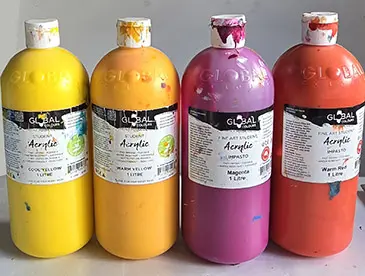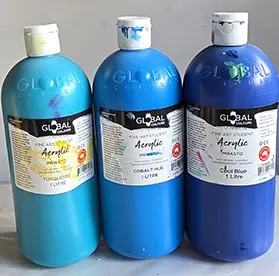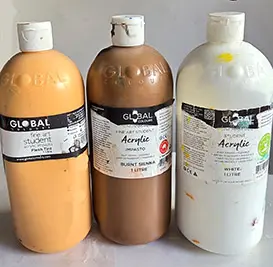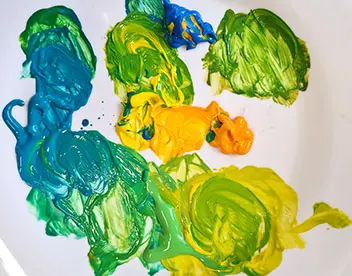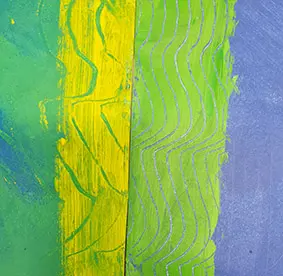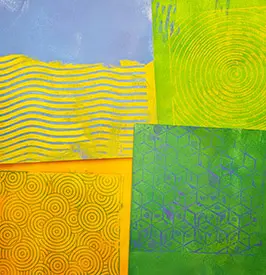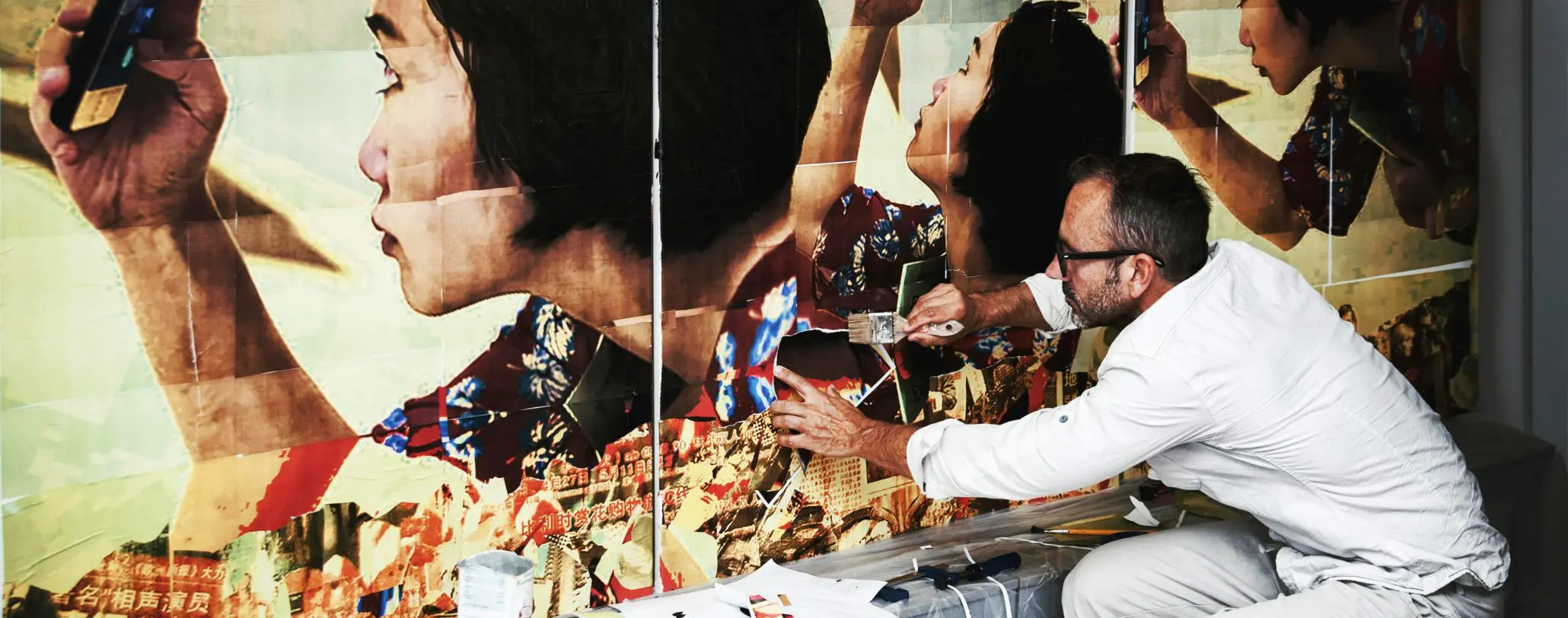Painting in primary school plays a vital role in children’s creative and emotional development. It helps young learners express ideas they can’t always put into words, builds fine motor skills, and strengthen their problem-solving and focus. Through painting, children can explore colour and texture while using their imagination. They can develop confidence, patience and a sense of pride in their own creations. It’s a foundation for creativity, communication, and joy in learning.
How to Set Up Your Primary Classroom for Painting
Painting is one of the most exciting and expressive art activities for children but it can get messy! A well-organised art room helps students stay focused, creative, and responsible while making clean up easier. Here are some ideas on how to set up your primary or elementary classroom for painting, plus smart art room management tips to make your sessions fun and productive.
1. Organise Your Painting Area
Defining areas in your classroom makes a huge difference to managing painting lessons. Is seems obvious but still worth mentioning to kids that painting is done on the tables, clean up at the sinks and works go on the drying racks at the end of the class. Point out the clean up area and drying rack location at the start of every painting class.
Tips for setting up your art room:
- Use washable or re-useable surfaces for painting: Cover tables with plastic sheets or use A3 painting mats made from thick paper or cardboard that can be re-used. Cardboard or paper mats can also be cut up and used for collage or art projects when they need to be replaced.
-
Provide aprons or art shirts: Store them in a tub or on hooks near the classroom door for easy access.
-
Label everything: Use clear, visual signs with pictures such as “Wash Brushes,” and “Drying Rack” so even younger students can follow routines independently. Some teachers like to use colour-coded tubs for each table with brushes, paints, and cleaning up sponges.
2. Choose and Prepare Painting Materials
Having the right materials ready keeps the class running smoothly and reduces waste. Set up an area with all the painting supplies so students can collect materials for their table. It builds responsibility and also lets them know where to return the supplies at the end of the class.
Essential art supplies for painting in the classroom:
-
Paint: Student-grade acrylic or liquid tempera paints are ideal. We use Global acrylics in the 1 litre containers and because they are not too heavy, kids aged 7 and up can get their own paint. The nozzle is small, restricting how much paint can be squeezed out quickly and most importantly, doesn’t clog up.
-
Our colour palette includes cool yellow, warm yellow, magenta, warm red, turquoise, cobalt hue or cerulean blue and some cool blue for water or darker greens. We also recommend fawn, burnt sienna,(which are great for animals and people) and white and black. Global paints have dense pigments so two coats will create an opaque background of solid colour. The pigments are intense and make beautiful colours when mixed. We recommend always mixing your colours to obtain a workable colour palette.
-
You will need to order lots of white as it is mixed with a wide range of colours and not much black. We also purchase some green and purple for the younger age groups to use. See the materials list for further recommendations for yearly ordering of painting supplies. Most paint pump dispensers end up getting clogged, so we don’t recommend them.
-
Oil paints should not be used for primary or elementary students as they are solvent based and require turpentine or mineral spirits for thinning and cleaning. They can irritate skin or eyes and may take weeks to dry. Ground level ventilation is needed to effectively remove fumes for a safe classroom environment. Even when labelled non-toxic, oil paints can contain trace amounts of heavy metals such as cadmium, cobalt, or chromium.
-
Brushes: Offer a mix of sizes and shapes. We recommend taklon brushes for acrylic painting, they usually have white or light brown brush bristles that are smooth and firm to the touch. A range of flat and round sizes work well for most painting projects, see below. (Oil painting brushes have coarse bristles, likes hogs hair and aren’t suited to acrylic paints).
Water containers, foam roller Taklon brushes, melamine plate Mixed paint colours in water containers -
Water containers: We recommend the plastic water containers with a wide base and narrower top as they are the most stable. They are available from educational art supply shops. One between two students works well. They can also be used to mix up paint colours such as the gelato palette above.
-
Palettes: After much experimentation over many years, we settled on using small white melamine plates for palettes (20cm/8″ diameter). It easy to see the colours when mixing. They can be easily washed with a scratchy kitchen sponge and are durable so can be used for many, many years. They are also small and stack well in tubs for storage. See what works for you, other art teachers swear by muffin trays, ice cube trays with lids for storing mixed colours or old egg cartons.
- Left over paint: A few kids may have excess paint due to trials with colour mixing. We paint copy paper, cartridge or newspaper with left over paint. This creates a ready made supply of painted paper for future collage and printmaking projects. It reduces waste and there is then very little paint on the palettes to be washed off. It is also a good activity for early finishers. The painted papers below have two layers of paint applied, one background colour and another patterned or printed.
3. Manage the Mess Without Losing Your Mind
Painting days can be fun and organised! Here are some classroom painting management tips:
-
Assign paint monitors: At the beginning of the class students collect brushes, palettes and water containers for their table, saving time and building teamwork.
- Paint supply: We limit the amount of paint that is put on a palette so there is little waste. Kids can share colours they have mixed by swapping palettes. Most projects need more paint at the start to paint the background and less paint each week as the project progresses. I choose a coin such as an Australian 50c or 20c piece and that is the size for the amount of paint that is needed for each colour on the palette. At the start of a project, we often use foam rollers and painting trays to roll the paint onto the background. Different colours can be mixed on the trays giving kids the choice from a wide range of colours. I would have 8 different colours for a class of 32 kids. It saves on a lot of cleaning up and the paint dries very quickly this way making it easy to paint two layers in one session. If kids apply paint with a brush it can end up being patchy, uneven or very thick and take ages to dry.
- Have kids think about their colour palette before getting paint. What will they need for the painting session? Warm or cool colours, lots of white or just fawn and burnt sienna?
-
Cleaning supplies: We use double sided sponges for cleaning the palettes. The scratchy side can get any residual paint off in a few seconds and then palettes are stacked up on a dish rack to drain and dry. We can also use the same type of sponges to clean paint off the plastic sheets and then two cloths to dry each table. Keep a few spare cloths or paper towel handy to mop up any spills.
-
Use drying racks: Have kids write their name and grade on the back of each work at the start of a project in the top right hand corner. This makes it easy to find for the teacher and prevents lost and unnamed works. Label works on the drying rack by class or group to keep the works organised.
-
Have a cleanup routine: Allow 10–15 minutes for cleaning up. Turn it into a game — “Can we beat the cleanup clock?” As kids get used to the clean up routine you may be able to cut this time. I demonstrate to kids how paint brushes are to be washed and then have a brush monitor to check them to see if they are clean before being left to dry. Brushes are expensive and will last a long time if properly cared for. I always check them after the class as well!
4. Encourage Creative Confidence
Painting lessons are about discovery, not perfection. You can build your students’ confidence by focusing on the process. Children’s creativity grows when they feel free to take risks and make mistakes.
-
Praise experimentation, colour mixing and creating textures.
-
Demonstrate and teach techniques like colour mixing and brush care before letting the kids loose on supplies.
-
Start the term with structured projects before moving to open-ended creative painting, this will help develop confidence in your students.
- Display their artwork in the classroom or hallway.
Create a Space for Creativity to Flourish
Setting up your classroom for painting doesn’t need to be complicated. With a bit of planning and clear routines, your art room can become a vibrant, inspiring space where every child feels like an artist.
At Creative Kids Art Lessons, we believe art education should be joyful, organised, and full of exploration. A well-set-up painting classroom gives students the confidence and freedom to express their ideas and lets teachers enjoy the process too!
Projects in our Painting unit for Kinder to Year 6
Interested in more Painting projects?
Try out some of these for K-6:
Surrealist portrait in All About Me
Vegetable Garden and Kiwi Fruit in Healthy Eating
John McKie inspired painting in More About Me
Dean Russo Dog in Pets
Acorn Banksia and Pete Cromer Owl in Art from Australia
Rover Thomas, Makinti Napanangka inspired paintings in Australian Aboriginal Art 1
Boomerang and Malaluba Gumana inspired painting in Australian Aboriginal Art 2
Gond folk art in India
Cactus bowl in Mexico
Lotus flowers in South East Asia
Zany Zebra in African Animals
Underwater Scene in Aquatic
Baby Koala, Bilby and Kangaroo in Australian Animals
Guinea fowl in Birds
Monarch butterfly in Bugs and Beetles
Zentangle fish in Fish
Imaginary garden, Lily and Magnolia collage in Flowers
Mia Charro Landscape, tonal and atmospheric landscapes in Landscapes
Owl painting and anthropomorphic owl in Owls
Turtle Painting in Sea Life
Monstera painting in Trees and Plants
Penguin artwork in Arctic and Antarctic
Mother’s Day Bright blooms in Celebrate and Remember
Catching Snowflakes in Summer and Winter
Pop Art Dog or Cat, endangered animal in Andy Warhol
Pete Cromer Black Cockatoo or Ring Necked Parrot in Australian Artists
Grotti Lotti Kookaburra and Jessie Breakwell Giraffes in Australian Artists
Grotti Lotti Budgie, Grant Haffner Landscape and Sandrine Pelissier Imaginary Flowers in Contemporary Artists
Berthe Morisot puppy, Monet tulip field, Mary Cassat Lilacs in Impressionists
and many, many more.
Latest Articles
Popular kids art lessons for teachers and ideas for the artroom
Painting in primary school plays a vital role in children’s ...
Why Drawing Is the Foundation of All Art and Essential ...
Inspiring Young Minds: Exploring Contemporary Artists in the K–6 Art ...



